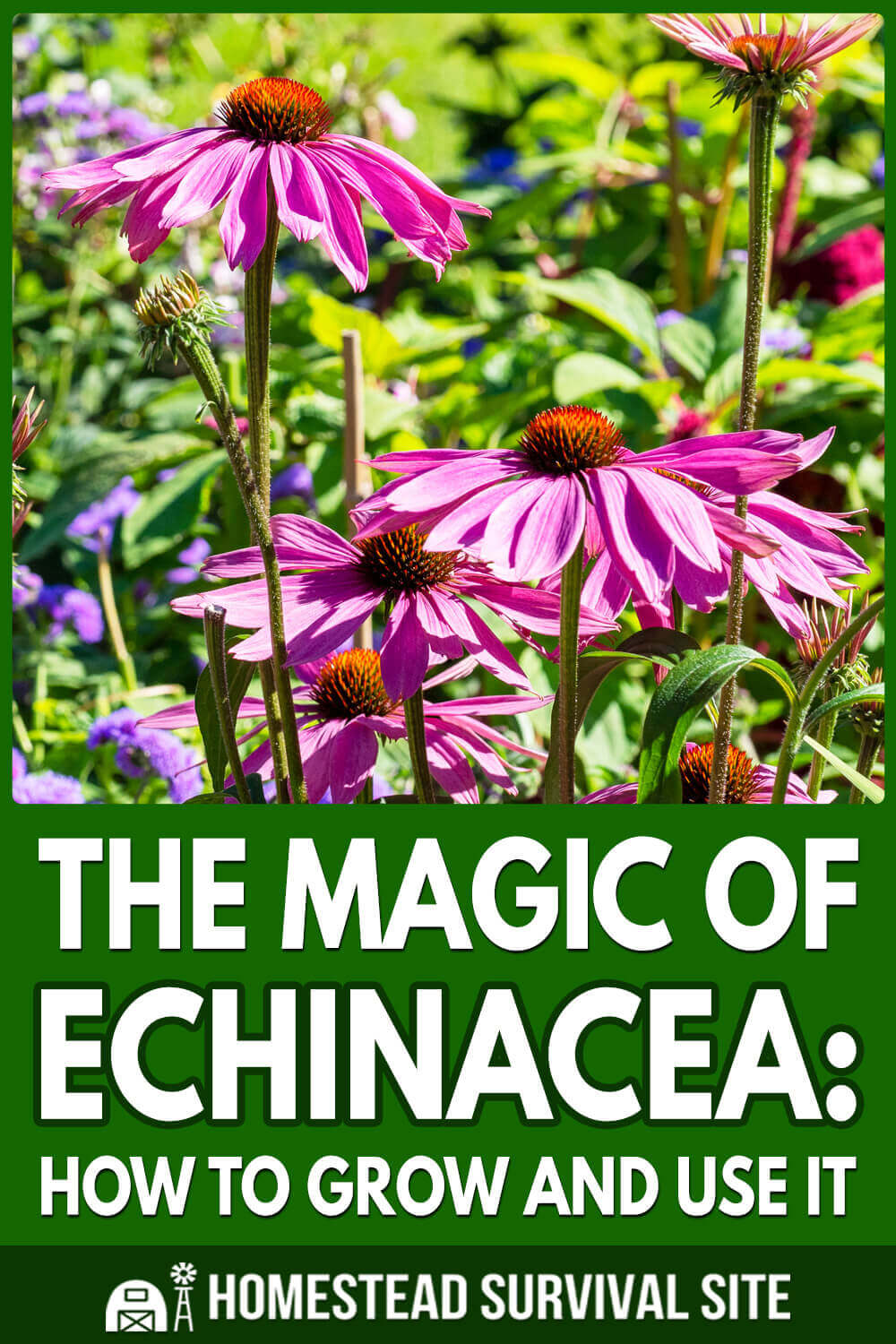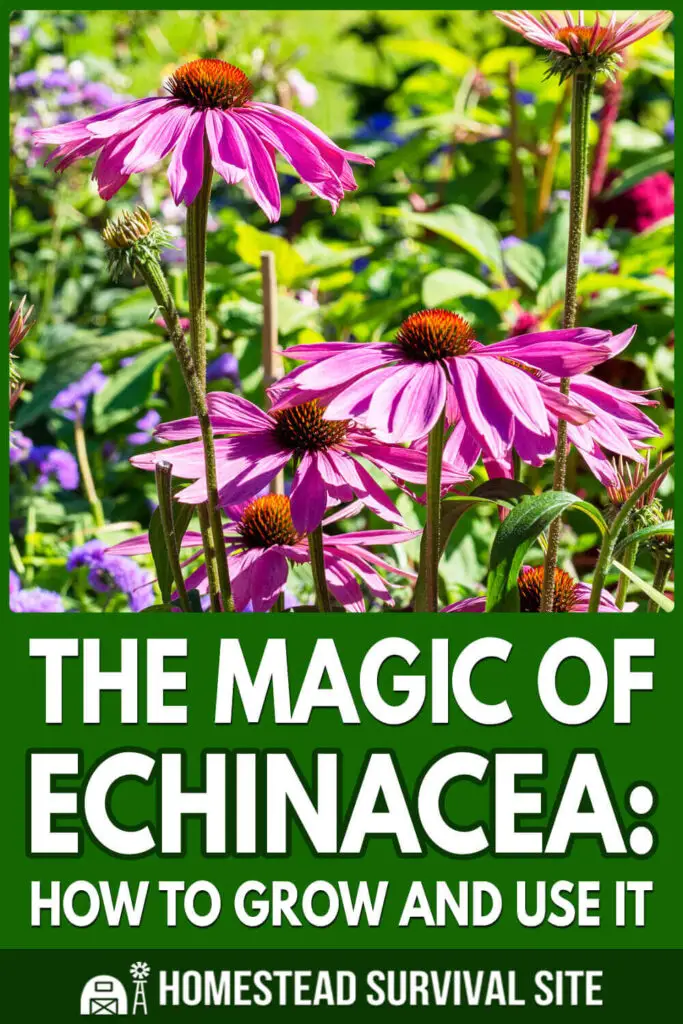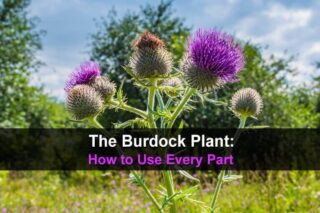Estimated reading time: 8 minutes
I love tending to my garden, especially my patch of coneflowers. Also known as echinacea, these hardy daisy-like flowers produce blooms for most of the year, in a variety of colors.
Pollinators, birds, and butterflies all flock to echinacea for its nectar and seeds, making it beneficial for both you and your local ecosystem. You can enjoy beautiful flowers as well as diverse wildlife.
Planting, growing, and using echinacea for medicinal purposes is easier than you think, and you may come to value this humble herb in your homesteading just as much as I do.
Want to save this post for later? Click Here to Pin It On Pinterest!
What is Echinacea?
Echinacea purpurea or purple cornflower is a member of the daisy family, which explains its large orange-yellow centers and many surrounding petals. Not only is it a beautiful addition to any homesteader’s garden, it has a myriad of health benefits that I will go into soon.
Echinacea is a prairie loving plant, one that thrives in open areas and even some locations with drought conditions. It is native to North America but is grown worldwide given how easily it takes to many climates and soil conditions.
Packed full of vitamins, minerals, and other health benefits, echinacea is a nutritional powerhouse. Isn’t it nice to have a plant that grows easily, flourishes in many climate conditions, and has a lot to offer the human body? Echinacea ticks all of these boxes!
This plant has been sold in supplement or medicinal form for quite some time, as the entire plant (from flower head to root) can be powdered. But why take echinacea? What might some of the medicinal benefits be?
Health Benefits of Echinacea
Echinacea may seem like a simple daisy or ornamental flower, but this plant is chock full of value, especially if you are interested in homemade and all natural herbal remedies like I am. Here are some of the top health benefits of echinacea.
Immune and Respiratory Health
The top use for echinacea has to be improving your overall immunity and respiratory system health. This delicate flower is used in over the counter treatments primarily for reducing the length of common colds, or even easing many flu symptoms.
I take echinacea at the first sign of a cold, right when I start to get the sniffles. Taking this herbal supplement props up my immune system, and I find that I can stop a cold dead in its tracks, or at the very least temper my cold symptoms!
Antioxidants
While there are countless antioxidants out there, all with complicated names, you can feel good about taking echinacea for its many antioxidant properties. This plant is full of them, the majority of which are found in the flower’s head and petals.
Antioxidants essentially help your cells fight stress or other long-term diseases, and echinacea is full of them. Echinacea also contains compounds that further the life of existing antioxidants, making it a great plant for ongoing antioxidant health. It both provides new, healthy antioxidants to your body and maintains them should you take echinacea supplements regularly.

Calming Effects
Anxiety is something I struggle with every single day. Thankfully, there are many plants that offer anti-anxiety properties, and echinacea is one of them. Many members of the daisy family have this benefit; you’ve heard of chamomile too, I bet. Same family, similar anxiety benefits.
Taking echinacea daily in supplement form can assist with feelings of anxiety, leading to an overall reduction in your nervous energy and thoughts. I love to whip up a cup of chamomile and echinacea tea before bed; I always sleep wonderfully after a cup of these calming herbs!
Inflammation Ease
Many herbs and plants offer anti-inflammatory benefits, and echinacea is one of them. Taking supplements can reduce your body’s overall inflammation and increase your body’s natural ability to heal.
Inflammation is linked to many chronic diseases, from Alzheimers to osteoporosis. Taking echinacea can reduce harmful inflammation, and committing to it for a long period of time could assist with any chronic pain that you may be experiencing.
Skin Health
Yes, echinacea is even good for your overall skin health too! While it isn’t very shelf stable and therefore has trouble making its way into mainstream beauty production, homemade echinacea beauty balms can be a great addition to your morning routine!
Because of its anti-inflammatory properties, this herb can reduce your skin’s overall redness and puffiness, and has many hydrating aspects as well. It is also full of anti-bacterial properties, making it an excellent acne and rash fighter too.
How to Grow Echinacea
Growing echinacea is easy to do no matter your experience level with plants or herbs. I always recommend members of the daisy family as good choices for first-time growers, as most will take to any soil or climate and adapt with ease.
I’ve killed my fair share of plants so that you don’t have to. Here is my how-to guide for growing echinacea flowers!
- Echinacea should be planted from seed or from small starts in spring, once the final frost has occurred and the soil has begun to warm. Planting from seed is easy to do with echinacea as it is an herb that propagates itself easily from its own seeds at the end of the season. However, keep in mind that most young echinacea plants won’t flower their first year; it usually takes them until their second or third year to flower should you grow from seed.
- Ensure that your soil is well-drained, even a little dry, and that your desired echinacea patch is in full sun. I’ve had this plant grow tall enough to shade other parts of itself, and these shaded sections have died off! You can always prune and adjust this plant to your liking so this doesn’t happen; no matter what, keep their patch of dirt sunny and dry!
- Plant your seeds in disturbed and turned over soil; plant your seeds an inch or so deep. Ensure that there are a couple inches separating each seed in case they all take, but most of the time, echinacea will find its own way to sprout, even if the seeds are crowded!
- Water decently as the spring turns into summer, especially if your echinacea is young and trying to grow for the first time. Once you have an established plant, echinacea can be watered a lot less, usually adapting to the natural outdoor climate that it has been planted in. However, if you notice their large flowered heads drooping, take the time to give them a bit of extra water!
- You can grow echinacea in a container if you’d rather, though ensure it is at least three gallons. I find them to be more high-maintenance this way, but they do make festive and cheery container plants! Water the container deeply when the soil dries out, and consider keeping them in partial shade. The most important part? Ensuring that the container has proper drainage!
Using and Consuming Echinacea
Since echinacea is easy to grow and harvest, I highly recommend using and consuming it for many medicinal remedies. But how might you go about this, and what are the best ways to consume this herbal remedy?
I recommend cutting back your echinacea halfway through the summer, when you have a decent amount of blooms. You can cut them down nearly to the soil, leaving a little bit of stalk left should you like to have a second bloom in the late fall.
Take the stalks, flower head and all, and bind them into a bouquet. Hang these flower bundles upside down in a naturally dry place; I usually do this in my kitchen window, which gets a lot of early morning sun.
When the flowers, leaves, and stems have dried out thoroughly, you can grind or food process them into a powder. This powder is perfect for taking as a capsule or pill-form supplement. You can also pluck the petals and leaves from your dried bouquet and steep them in tea.
What are Some Potential Side Effects of Echinacea?
While most herbal remedies haven’t been properly studied for their many health benefits and potential side effects, echinacea remains a fairly safe herb to consume. Here are my recommendations for your echinacea consumption:
- Use echinacea up to three times daily when you are experiencing cold symptoms.
- Always take supplements or tea with food, as echinacea has been known to upset stomachs.
- Echinacea can be safely taken for up to two weeks at a time, but taking this herb consistently over a long period of time has not been properly studied.
- The main side effects of echinacea usually occur if you have natural allergies to the plant; it can agitate existing allergy symptoms as well as asthma.
- If you have any immune system issues or take immunosuppressants, you should not take echinacea, given its ability to alter the immune system.
Conclusion
Echinacea is a wonderful plant to grow in your garden as it is easy to care for, comes in a variety of colors, and has many medicinal benefits. Even beginning homesteaders can feel confident growing this beautiful daisy!
Like this post? Don't Forget to Pin It On Pinterest!













